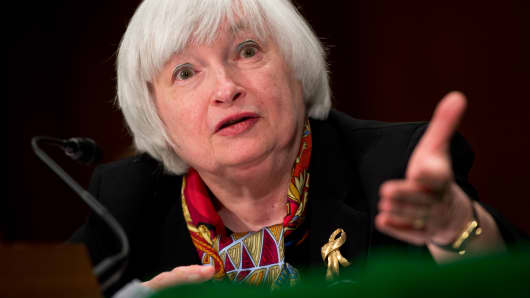That could mean the Fed will abandon focusing on only two strict variables when conducting monetary policy, the U-3 (or normal) unemployment rate, and a broadly-based inflation measure, and, instead, may now use a variety of indicators to determine when, OR WHETHER, it's time to not only completely wind down its bond-buying program, but also start raising short-term interest rates.
(Read more: Jobs-target shift in the works? All eyes on the Fed)
It could also mean that, given a more qualitative assessment, the Fed could EASE EVEN FURTHER, using new, and different, tools to stimulate economic activity ... if the Fed's qualitative measures suggest the economy is still too weak, relative to its growth potential.
This is a concept that may come up today, as the Fed offers new forward guidance on rate policy in its afternoon statement, and in Janet Yellen's first news conference as head of the Fed.
I will be looking for the word "qualitative" to be used at this, both momentous, and potentially portentous, meeting of the Federal Open Market Committee.
(Read more: Wall Street sharply divided on 2015: CNBC survey)
Given the Fed's oft-stated goal of beginning the rate hiking process when unemployment falls to 6.5 percent (now at 6.7 percent), some have suggested the Fed now believes that a single indicator is not the best measure of determining how much slack there is in the labor force, given the low employment population ratio (still near a 40-year low), underemployment that is far too high and far too many people who have abandoned the workforce altogether.
With inflation running about a full percentage point below the Fed's 2-percent target, it seems the Fed may engage in "qualitative easing," by possibly extending the more traditional quantitative easing if sufficient progress is not made on the employment front. Alternatively, the Fed could trim, or even eliminate, the 25 basis points it pays banks who hold excess reserves at the Fed.
A cut, or elimination, of interest on excess reserves (IOER), some believe, would force banks to take the money from the Fed and put it to more constructive uses, by lending it to businesses and individuals in need of credit.
In any event, I don't believe the Fed is near ready to discuss raising rates, even if it is ending QE as we know it.
(Read more: What are futures doing ahead of the Fed meeting? Click here)
The bond market may be telling us the Fed has more to do, and that its next iteration of policy will be more qualitative ... a judgement call, if you will, that, no doubt, will bring jeers from the Fed haters who believe anything the Fed does will harm the economy.
Once again, they are wrong. The Fed is not moving the goal posts, it's adjusting policy appropriately to address the issues that their counterparts in Congress and the White House are too timid to handle.
— By Ron Insana
Ron Insana is a CNBC and MSNBC contributor and the author of four books on Wall Street. He also delivers a daily podcast, "Insana Insights," and a long-form weekly version, both available on iTunes and at roninsana.com. Follow him on Twitter @rinsana.



